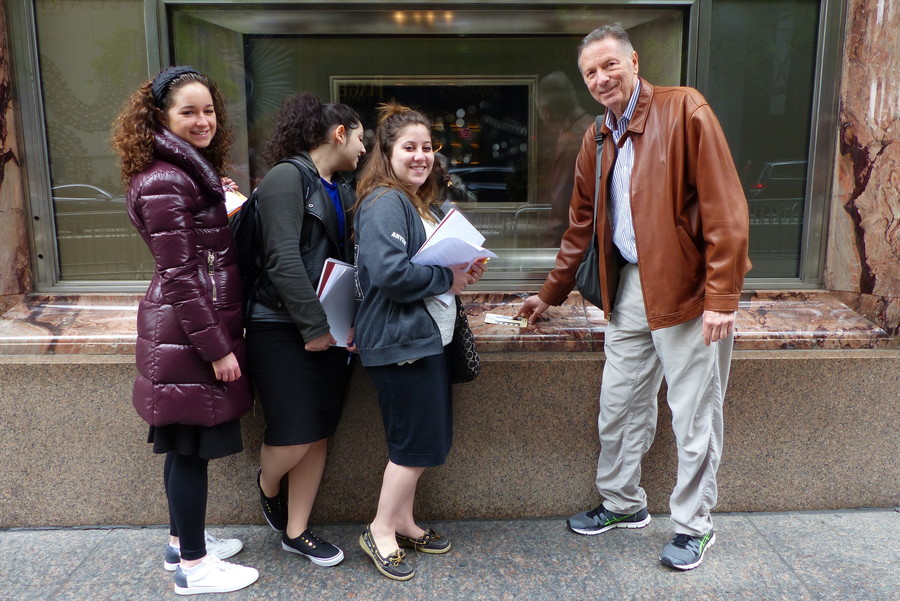History hidden in plain sight
On the last day of April, I had a mind-blowing experience.
I was invited to join Howard R. Feldman’s elective paleobiology class from Touro College for a geology tour of midtown Manhattan.
We met at East 61st Street and Fifth Avenue, and walked all the way to Grand Central Station, examining stone facades and flooring along the way. It is completely amazing what you do not see when your eye is untrained.
Architects use various types of stone for building facades. We saw brecciated limestone and travertine sandstone, marble and granite. Sandstone is probably the easiest to identify. When you touch it, it feels granular, like sandpaper. And by simply looking at it closely with a magnifier, you can see the quartz grains.
Anyone interested in the fine structure of stone, animals or plans should take one along on tours. I have a standard loupe, which is powered to 16x, and is invaluable.
Limestone and marble, which is a metamorphosed limestone, were not hard to identify either. You can show that a façade is made from either of them by dropping a bit of dilute hydrochloric acid on it. If bubbling occurs, then there has been a chemical reaction with the carbonate material of which it is made, which then causes the release of carbon dioxide gas, proving that the rock is either limestone or marble.
Granite, an igneous rock, is created under depth by cooling magma (molten material), and does not have fossil inclusions.
Our short walk took us through many geological periods — from the Paleozoic, approximately 541 millions years ago, practically to the present.
Our first stop was the Pierre Hotel where we saw brachiopods and learned about geopetal structures. Brachiopods are shelled creatures constituting their own phylum, and identification is made by examining the shells for symmetry.
Brachiopod shells are perfectly symmetrical in plain view, by asymmetrical in lateral view.
Geopetal refers to understanding, literally, which direction is up based on visible examination of the fossil. In this case, the brachiopod shell is small and clearly outlines. The lower half, where the organic part of the animal rested, became filled with sediment and is dark, while the upper half that had been filled with gas, was replaced with a sparry cement (essentially, a bright crystalline substance), and that area now appears white.
Since the animal lay on the ocean floor, the line between the mud and the cement tells us which direction was up (toward the sediment-water interface).
The Sherry Netherland Hotel is between 59th and 60th streets. It has limestone paneling on which you can find molds of small gastropods from the family Turritelidae — the tower shells. It is a member of the phylum Mollusca, and the elegant shell resembles a twisted cone large enough for the animal to completely retreat inside of in times of danger.
The Plaza Hotel is a symbol of elegance, but we stopped only to look at the limestone Pulitzer Fountain outside. Looking carefully near the neck of a feathered ram ornamenting the founding, we saw a round figure in the stone. This turned out to be a rudist.
Again, these are mollusks that lived from the late Jurassic to the late Cretaceous — a period of 90 million years between 155 million years ago, and 65 million years ago. Using my magnifying loupe though, I also saw tiny crinoids ossicles that look like tiny, round vertebrae.
Tiffany’s attraction that day was not jewelry, but the crinoid fossils in the limestone near the display windows. Crinoids, the sea lilies, belong to the phylum Echinodermata, and have a five-fold body plan, and include other creatures such as sea urchins, sand dollars and starfish.
Human and most higher animals have bilateral symmetry. The name “crinoids” comes from the Greek with krinon, meaning “lily,” and eidos, meaning “form.”
The crinoids fossil looks like an umbrella ribs, with the ribs folding upward. The stems are made up of round circular structures stacked one on top of the other, called ossicles. The crinoids made their appearance in the in the Ordovician — 485 million years ago — and are still with us today.
Moving south, we found a building façade that demonstrates cross-bedding, although once you recognize it, you see it everywhere. These are stacks of lines in sandstone with the layers lying one above the other, and represents the movement of sediment by wind or water.
These marks can indicate ripples, dunes and deltas, and are indicative of rivers as well as tide-dominated coastal and marine settings.
Although this tour lasted only two hours, we saw so much that I must break this column up into two parts. Please join me next week for the sequel.






